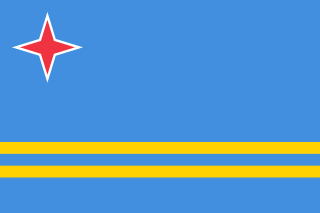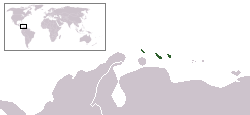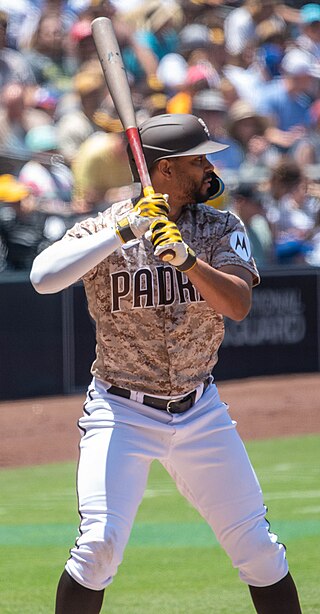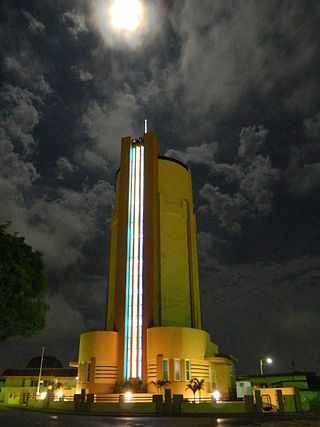
Aruba, officially the Country of Aruba, is a constituent country within the Kingdom of the Netherlands, in the southern Caribbean Sea 29 kilometres (18 mi) north of the Venezuelan peninsula of Paraguaná and 80 kilometres (50 mi) northwest of Curaçao. In 1986, it became a constituent country within the Kingdom of the Netherlands and acquired the formal name the Country of Aruba.

The Netherlands Antilles, also known as the Dutch Antilles, was a constituent Caribbean country of the Kingdom of the Netherlands consisting of the islands of Saba, Sint Eustatius, and Sint Maarten in the Lesser Antilles, and Aruba, Curaçao, and Bonaire in the Leeward Antilles. The country came into being in 1954 as the autonomous successor of the Dutch colony of Curaçao and Dependencies, and it was dissolved in 2010, when like Aruba in 1986, Sint Maarten and Curaçao gained status of constituent countries within the Kingdom of the Netherlands, and Saba, Sint Eustatius, and Bonaire gained status of special municipality of Netherlands as the Caribbean Netherlands. The neighboring Dutch colony of Surinam in continental South America, did not become part of the Netherlands Antilles but became a separate autonomous country in 1954. All the territories that belonged to the Netherlands Antilles remain part of the kingdom today, although the legal status of each differs. As a group they are still commonly called the Dutch Caribbean, regardless of their legal status. People from this former territory continue to be called Antilleans in the Netherlands.

Curaçao, officially the Country of Curaçao, is a Lesser Antilles island in the southern Caribbean Sea, specifically the Dutch Caribbean region, about 65 km (40 mi) north of Venezuela. It is a constituent country of the Kingdom of the Netherlands.

Transport in Aruba is facilitated by road, air, and rail. Aruba features a well-established road network, with the majority of the roads being paved. However, as one ventures towards the interior of the island, the prevalence of paved roads decreases, giving way to more rugged terrain. Conversely, coastal areas typically offer-well maintained paved roads. Aruba's road network covers a total distance of about 998 kilometres (620 mi), with 361 kilometres (220 mi) remaining unpaved.

The economy of Aruba is an open system, with tourism currently providing the largest percentage of the country's income. Because of tourism's rapid growth in the last 80 years, related industries like construction have also flourished in Aruba. Other primary industries include oil refining and storage, as well as offshore banking. Despite the island's low rainfall in the past year, the people have proven that Aruba's soil is full of nutrients and many crops do amazingly well in the soil. Many more locals have started participating more to horticulture, permaculture and agriculture. Creating a start to an internal economy. Aloe cultivation, livestock, and fishing also contribute to Aruba's economy. In addition, the country also exports art and collectibles, machinery, electrical equipment, and transport equipment. Aruba's small labor force and low unemployment rate have led to many unfilled job vacancies, despite sharp rises in wage rates in recent years.

Papiamento or Papiamentu is a Portuguese-based creole language spoken in the Dutch Caribbean. It is the most widely spoken language on the ABC islands.

Oranjestad, the capital and most populous of Aruba's eight regions, is located on the southwestern coast of the island. In Papiamento, the local language, Oranjestad is commonly referred to as "Playa" by the locals.

The culture of Aruba, encompassing its language, music, and cuisine, is diverse and has been influenced by both regional and foreign cultures. One significant foreign influence originates from the Iberian Peninsula, which had a significant impact on the island for approximately 137 years, starting c. 1500. These influences were characaterized by a strong religious presence, missionary activities, and economic exploitation.

Lago Colony was a community located on the east end of the island of Aruba, near the area presently known as Seroe Colorado.

Lago Oil & Transport Co. Ltd. was established in 1924 as a shipping company responsible for transporting crude oil from Lake Maracaibo to its transshipment facility on the island of Aruba. The Lago refinery, a subsidiary of the Standard Oil Company (Exxon), remained in operation until March 31, 1985 when Exxon made the decision to shut down and dismantle both the refinery and Lago Colony.

Baby Beach officially known as Klein Lagoen, is a shallow, sheltered man-altered lagoon located in the Mangle Cora locality near the village of Seroe Colorado, on the south-west side of the south-east end of the island of Aruba. It is frequented by locals and tourists. It is nicknamed Baby Beach as the water is so calm it is safe for very small children. Because of the calm water, snorkeling at this beach is safe for children and others new to snorkeling.

Seroe Colorado is a village situated at the southeastern tip of Aruba, an island located in the Dutch Caribbean. Nowadays, it is known for the Anchor in Memory to All Seamen. Historically, between 1878 and 1914, Seroe Colorado served as the location for the Colorado Guano Mine, which was involved in the extraction of guano. Additionally, the Seroe Colorado Lighthouse can be found in this village, serving as a prominent landmark.

The attack on Aruba was an attack on oil installations and tankers by Axis submarines during World War II. On 16 February 1942, a German U-boat attacked the small Dutch island of Aruba. Other submarines patrolled the area for shipping and they sank or damaged tankers. Aruba was home to two of the largest oil refineries in the world during the war against the Axis powers, the Arend Petroleum Company, situated near the Oranjestad harbor, and the Lago Oil and Transport Company at the San Nicolas harbor. The attack resulted in the disruption of vital Allied fuel production.

Xander Jan Bogaerts is an Aruban professional baseball shortstop and second baseman for the San Diego Padres of Major League Baseball (MLB). He has previously played in MLB for the Boston Red Sox. He represents the Netherlands national baseball team in international competition.

Rodgers Beach, Aruba, officially known as Nanki is a small beach immediately west of Baby Beach. It is known for its calm waters and private feel, though it is a public beach. The water is shallow at first, but further out it becomes a good swimming beach.
Afro-Arubans are Arubans who have predominantly African ancestry. Afro-Arubans are a minority ethnic group in Aruba, although many Arubans may have African ancestry. They speak Papiamento, an Afro-Portuguese creole language commonly spoken on the ABC islands. The language dates back at least 300 years and is based on African linguistic structures combined with vocabulary from Portuguese, Dutch, and Spanish. Like other Arubans, Afro-Arubans also speak Dutch, Spanish, English, as well as other languages.

Aruba is an island in the Caribbean that hosts many sports events to fuel its economy.

Water Tower San Nicolas is a water tower and museum in San Nicolaas, Aruba. It was built in 1939 to relieve the water shortage in Aruba. In 1979, the tower became obsolete and in 1996, it was transferred to the monument fund, and restored. In 2016, the industry museum opened in the tower.
San Nicolaas English, also known as Bush English, is a variety of Caribbean English spoken in the town of San Nicolaas in Aruba. It is spoken by many of the town's estimated 15.000 residents. It is also spoken by a smaller number of speakers in other parts of Aruba. San Nicolaas English is often spoken alongside Papiamento, one of the official languages of Aruba.



















